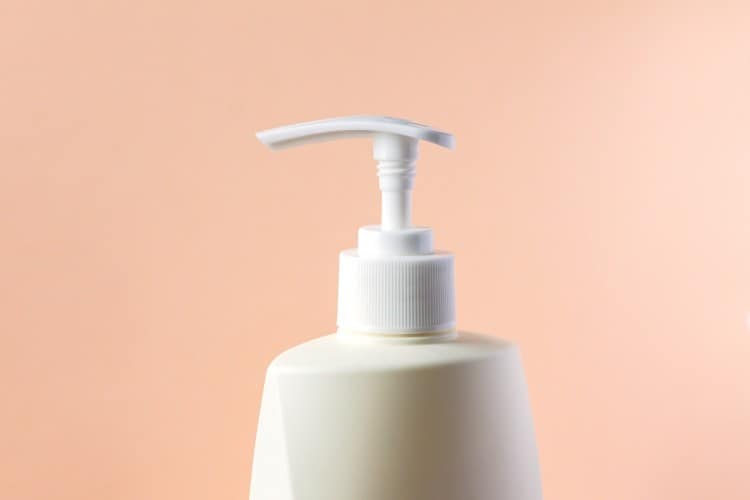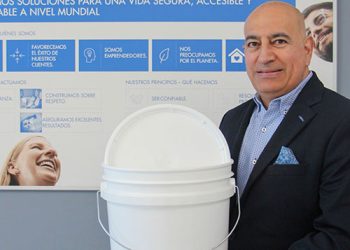Designers created a pump with an enclosed plastic spring that can be broken down in standard recycling streams without further processing.
Writing in a recent U.S. patent , multinational personal beauty care company Procter & Gamble details how their innovative design fills a pressing need for consumers and manufacturers alike, stating, “there is a need for a pump dispenser that has a pump assembly where used pump assemblies do not require disassembly to be recycled in current recycling streams.”
To accomplish this, there is also a “need for a pump assembly with a plastic spring where the spring does not lose stiffness over time and does not interact with the liquid product.”
The current pump problem
Pump dispensers are used throughout the beauty and personal care industries in various products and applications, including cosmetics, shampoo, conditioner, and lotions. Most pumps are constructed with polyethylene (PE) or polypropylene (PP) components and typically feature a steel spring, which allows the pump assembly to dispense product “when a user pushes down on (or primes) the pump head.
This causes the piston to put “pressure on the spring and move a ball valve upward, taking some product with it. When the pump head is released, the piston and spring return to the resting positions, sealing off the housing chamber to stop liquid from flowing back up into the bottle.”
Unfortunately, while most PE or PP components in current designs can generally be recycled, “the presence of the steel spring in the pump assembly can make it difficult to recycle the pump dispenser in current recycling streams.” Steel springs are currently in favor “because they are inexpensive, relatively stiff with little deformation over time while still being relatively easy to actuate, and generally do not react with most liquid beauty and personal care products
Therefore, the P&G research team sought to design instead an alternative “pump dispenser that comprises only recyclable plastics from the same material recycling class, as defined by the Society of Plastics Industry, including a plastic spring
Drawbacks to current alternatives
Current plastic spring designs have several drawbacks, which P&G researchers looked to improve in their design. For example, “in pump assemblies with metal springs, the spring is in contact with the liquid product during use.” Steel is a relatively inert material; this causes little to no interaction with the product.
However, plastics like PP and PE “can be more reactive than steel to some chemistries, which can cause the spring to have a modulus change (either stiffening or loosening) or even stress-breaking by the interaction between the spring material and the liquid product.”
Further drawbacks to the current design include the possibility that material from the plastic spring “can leach into the liquid product, compromising the safety and efficacy of the product .” Additionally, plastic springs have an “ elastic modulus that is 50× to 150× lower than steel, and if they are subjected to this compressive force in a locked storage configuration, there can be significant deformation and the pump assembly will not work as well
Proposed solutions and results
To address these concerns, researchers created two different pump dispenser designs, testing a total of six different versions of the designs on criteria including Average Output per Stroke (OPS), Pump Average Peak Force to Actuate & Return Time, and Spring Specifications Peak Force to Actuate to determine the optimal combination of design factors.
Both dispenser designs include a dual-stem design with housing at least partially surrounding the second stem, with the first stem including an end rigidly attached to the pump head. Additionally, both designs feature a pump head adapted to receive an end of the first stem and a closure coupled to the neck of the body.
The first dispenser design specifically utilized a bottle “ comprising a neck having a neck landing zone; wherein the bottle consists essentially of polypropylene, polyethylene, or polyethylene terephthalate ,” while the second design features “ a neck wherein the bottle contains a fluid product.
Following testing, designers determined that in the ideal variation of the first design, the pump assembly “consists essentially of polypropylene or polyethylene .” For the second design, the pump assembly “comprises at least 80% of one kind of recyclable plastic selected from the group consisting of polyethylene, polypropylene, polyethylene terephthalate, and combinations thereof.”
The potential industry impact
According to a recently published study by the Environmental Protection Agency, Americans have tripled their production of municipal solid waste (MSW), which includes plastics, from 88.1 million tons produced in 1960 to 292.4 million tons in 2018. That same year, approximately 24% of MSW was recovered for recycling – an average of 1 pound per capita per day of the 5 pounds per capita per day produced.
Recycling rates have remained relatively steady since 2005, indicating that American consumers consider sustainability in their purchasing habits. However, in 2017 China banned the import of all but the highest quality plastic for processing, significantly impacting municipal recycling programs across the United States.
The cosmetics industry, a large producer of plastic product packaging, should therefore take note of the design innovation detailed in P&G’s recent patent filing. As consumers continue to gravitate towards more natural and sustainable products, it is logical to assume that a completely recyclable packaging option will be highly marketable in the coming months and years.
Packaging 360 is a comprehensive knowledge sharing ecosystem for the Indian packaging industry. Our services include an online content platform to deliver news, insights and case studies; organising conferences seminars and customised training; Providing Bespoke Project Consulting, Market Research and Intelligence.







